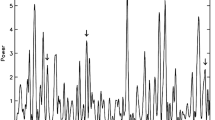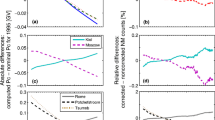Abstract
The currently available data on solar neutrino flux variation in radiochemical experiments and Cherenkov measurements have so far defied a simple interpretation. Some of the results concerning these variations are indicative of their relationship to processes on the solar surface. It may well be that a poorly understood, uncontrollable factor correlating with solar activity indices affects the neutrino flux measurements. This factor is assumed to modulate the detection efficiency on different detectors in different ways. To test this assumption, we have analyzed all available radiochemical measurements obtained with the Brookhaven (1970–1994, 108 runs), GALLEX (1991–1997, 65 runs), and SAGE (1989–2000, 80 runs) detectors for possible instability of the detection efficiency. We consider the heliophysical situation at the final stage of the run, the last 7–27 days, when the products of the neutrino reaction with the target material had already been accumulated. All of the main results obtained previously by other authors were found to be reproduced for chlorine-argon measurements. The neutrino flux anticorrelates with the sunspot numbers only for an odd solar cycle. A similar behavior is observed for the critical frequencies of the E-ionosphere. The neutrino flux probably correlates with the A p magnetic activity index only for an even solar cycle. The predominance of a certain sign of the radial interplanetary magnetic field (IMF) in the last 14 (or 7) days of the run has the strongest effect on the recorded neutrino flux. The effect changes sign when the polarity of the general solar magnetic field is reversed and is most pronounced for the shortest runs (less than 50 days). The dependence of the flux on IMF polarity completely disappears if the corresponding index is taken for the first rather than the last days of the run. The IMF effect on the recorded neutrino flux was also found for short runs in the gallium-germanium experiment, but this effect for a given time interval in the SAGE measurements is opposite in sign to that detected with the Brookhaven and GALLEX detectors. The anticorrelation with the A p activity index, which is absent in the SAGE measurements, contributes significantly to the flux variations on the GALLEX detector. If a magnetic storm with a sudden commencement occurs in the last 7 days of the run, then an effect of generally the same type, a significant increase in the variance, is observed for all three detectors. In all other indices, the flux variations on the Brookhaven and GALLEX detectors are the opposite of those on the SAGE detector. We have found that the GALLEX and SAGE measurements for the runs that ended simultaneously, to within about 10 days or less, anticorrelate, while the Brookhaven and GALLEX measurements correlate. We conclude that there are fictitious variations in the measurements under consideration that are attributable to the influence of geophysical factors (probably, very-low-frequency electromagnetic fields) controllable by solar activity on the physical-chemical kinetics of the target material. We discuss possible experiments to check whether the detected effects are real. If all of these effects are indeed real, then the neutrino flux was underestimated in the radiochemical measurements.
Similar content being viewed by others
References
G. A. Bazilevskaya, Yu. I. Stozhkov, and T. N. Charakhch’yan, Pis’ma Zh. Éksp. Teor. Fiz. 35, 273 (1982) [JETP Lett. 35, 341 (1982)].
J. N. Bahcall, Neutrino Astrophysics (Cambridge Univ. Press, Cambridge, 1989; Mir, Moscow, 1993).
J. W. Bieber, D. Sechel, T. Stanev, and G. Steigman, Nature 348, 407 (1990).
J. N. Bahcall and W. H. Press, Astrophys. J. 370, 730 (1991).
D. S. Oakly, H. B. Snodgrass, R. K. Ulrich, and T. L. Van De Kop, Astrophys. J. 437, L63 (1994).
V. N. Obridko and Yu. R. Rivin, Astron. Astrophys. 308, 951 (1996).
Yu. R. Rivin, Circles of the Earth and Sun (Nauka, Moscow, 1989), p. 48.
L. I. Dorman, V. L. Dorman, and A. W. Wolffendale, in Contributed Papers of 23rd ICRC (Calgary, 1993), Vol. 3, p. 872.
Yu. R. Rivin, Astron. Zh. 70, 392 (1993) [Astron. Rep. 37, 202 (1993)].
P. A. Sturrock, G. Walther, and M. S. Wheatland, Astrophys. J. 507, 978 (1998).
L. I. Dorman, Yad. Fiz. 63, 1064 (2000) [Phys. At. Nucl. 63, 984 (2000)].
S. Massetti and M. Storini, Astrophys. J. 472, 827 (1996).
D. Basu, Sol. Phys. 81, 363 (1982).
R. Wilson, Sol. Phys. 149, 391 (1994).
R. L. McNutt, Science 270, 1635 (1995).
Ph. Delache, V. Gavryusev, E. Gavryuseva, et al., Astrophys. J. 407, 801 (1993).
H. J. Haubold and E. Gerh, Astron. Nachr. 306, 203 (1985).
H. J. Haubold and E. Gerh, Sol. Phys. 127, 347 (1990).
V. Gavryusev, E. Gavryuseva, and A. Roslyakov, Sol. Phys. 133, 161 (1991).
I. Liritzis, Sol. Phys. 161, 29 (1995).
P. A. Sturrock, G. Watlher, and M. S. Wheatland, Astrophys. J. 491, 409 (1997).
G. Walther, Astrophys. J. 513, 990 (1999).
J. Boger, R. L. Hahu, and J. B. Cumming, Astrophys. J. 537, 1080 (2000).
R. B. Wilson, Astrophys. J. 545, 532 (2000).
P. A. Sturrock, J. D. Scargle, G. Walther, and M. S. Whieatlend, Astrophys. J. 523, L177 (1999).
P. A. Sturrok and J. D. Scargle, Astrophys. J. 550, L101 (2001).
Y. Fukuda, T. Hayakawa, K. Inoe, et al., Phys. Rev. Lett. 77, 1683 (1996).
Yu. V. Kozlov, V. P. Martem’yanov, and K. N. Mukhin, Usp. Fiz. Nauk 167, 849 (1997) [Phys. Usp. 40, 807 (1997)].
Y. S. Kopysov, in Proceedings of International Conference Neutrino-82 (Budapest, 1982), Vol. 1, p. 274.
O. V. Chumak and V. N. Oraevsky, in Proceedings of Fourth SOHO Workshop on Helioseismology, ESA SP-376, Pacific Grove, USA (1995), p. 59.
B. M. Vladimirskii and L. D. Kislovskii, Izv. Krym. Astrofiz. Obs. 82, 153 (1990).
A. I. Khlystov, V. P. Dolgachev, and L. M. Domozhilova, Tr. Gos. Aston. Inst., Mosk. Gos. Univ. 64, 91 (1995).
K. S. Jacobs, Nature 256, 560 (1975).
V. P. Vasil’ev and A. I. Kalinichenko, in Studies on Physics of Cosmic Rays (Yakutsk, 1985), p. 62.
S. É. Shnol’, V. A. Kolombet, E. V. Pozharskii, et al., Usp. Fiz. Nauk 168, 1129 (1998) [Phys. Usp. 41, 1025 (1998)].
S. E. Shnoll, E. U. Pozharskii, T. A. Zenchenko, et al., Phys. Chem. Earth A 24, 711 (1999).
V. P. Izmailov, O. V. Karagioz, and A. G. Parkhomov, in Atlas of Time Variations of Natural, Anthropogenic, and Social Processes (Nauchnyi Mir, Moscow, 1998), Vol. 2, p. 163.
B. M. Vladimirskii and A. V. Bruns, Biofizika 43, 720 (1998).
V. M. Lobashov, V. N. Aseev, A. I. Belesev, et al., Phys. Lett. B 460, 227 (1999).
B. M. Vladimirskii and N. A. Temur’yants, Solar Activity Impact on the Biosphere-Noosphere (MNÉPU, Moscow, 2000) [in Russian].
B. T. Cleveland, T. Daily, R. Davis, et al., Astrophys. J. 496, 505 (1998).
L. A. Antonova, G. S. Ivanov-Kholodnyi, and V. E. Chertoprud, Aeronomy of the E Layer (Yanus, Moscow, 1996) [in Russian].
P. Anselmann et al. (GALLEX Collab.), Phys. Lett. B 314, 445 (1993).
P. Anselmann et al. (GALLEX Collab.), Phys. Lett. B 327, 377 (1994).
P. Anselmann et al. (GALLEX Collab.), Phys. Lett. B 388, 384 (1996).
P. Anselmann et al. (GALLEX Collab.), Phys. Lett. B 447, 127 (1999).
P. Anselmann et al. (GALLEX Collab.), Phys. Lett. B 447, 440 (1999).
N. V. Udal’tsova, V. A. Kolombet, and S. É. Shnol’, Possible Space Physical Dependence of Macroscopic Fluctuations (Pushchino, 1987).
A. V. Bruns, B. M. Vladimirskii, L. G. Limanskii, and S. M. Shumko, in Solar Physics: Proceedings of 7th Symposium of Russia and CIS Countries on Solar-Terrestrial Physics (Troitsk, 1999), p. 179.
Author information
Authors and Affiliations
Additional information
__________
Translated from Zhurnal Éksperimental’no\(\overset{\lower0.5em\hbox{$\smash{\scriptscriptstyle\smile}$}}{l}\) i Teoretichesko\(\overset{\lower0.5em\hbox{$\smash{\scriptscriptstyle\smile}$}}{l}\) Fiziki, Vol. 125, No. 4, 2004, pp. 717–733.
Original Russian Text Copyright © 2004 by Vladimirski’, Bruns.
Rights and permissions
About this article
Cite this article
Vladimirskii, B.M., Bruns, A.V. On the presence of fictitious solar neutrino flux variations in radiochemical experiments. J. Exp. Theor. Phys. 98, 629–642 (2004). https://doi.org/10.1134/1.1757662
Received:
Issue Date:
DOI: https://doi.org/10.1134/1.1757662




